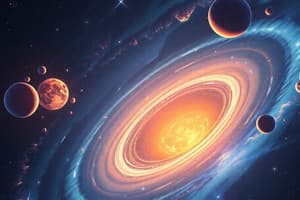Podcast
Questions and Answers
What is the primary process described in the formation of the solar system?
What is the primary process described in the formation of the solar system?
- Nebular Theory (correct)
- Erosion and sedimentation
- Plate tectonics
- Nuclear fusion
What effect does increasing rotation speed have on the disk of material during solar system formation?
What effect does increasing rotation speed have on the disk of material during solar system formation?
- It halts the formation of planets
- It makes the central region of the disk flatten out (correct)
- It leads to fragmentation of the disk
- It causes the temperature to decrease
Which of the following accurately describes the initial state of the material in the solar system's formation?
Which of the following accurately describes the initial state of the material in the solar system's formation?
- A stationary cloud of ice
- A stream of comets and asteroids
- A rotating disk of gases and dust (correct)
- A solid mass
In the Nebular Theory, what forms at the center of the rotating disk?
In the Nebular Theory, what forms at the center of the rotating disk?
What role does gravitational collapse play in the formation of the solar system according to the Nebular Theory?
What role does gravitational collapse play in the formation of the solar system according to the Nebular Theory?
What ultimately formed from the remaining material of the flat disk in the nebular theory?
What ultimately formed from the remaining material of the flat disk in the nebular theory?
What happens to the material in the center of the nebula as it collapses?
What happens to the material in the center of the nebula as it collapses?
Which statement accurately describes a consequence of the nebula's collapse due to gravity?
Which statement accurately describes a consequence of the nebula's collapse due to gravity?
What is the initial form of the solar system before it undergoes the transformation described in the nebular theory?
What is the initial form of the solar system before it undergoes the transformation described in the nebular theory?
What action occurs to the nebula during the formation of the solar system?
What action occurs to the nebula during the formation of the solar system?
The nebula that formed the solar system was made up of mainly solid materials.
The nebula that formed the solar system was made up of mainly solid materials.
According to the nebular theory, the Sun formed from the densest part of the collapsing nebula.
According to the nebular theory, the Sun formed from the densest part of the collapsing nebula.
In the formation of the solar system, the remaining material after the Sun's formation became the asteroids.
In the formation of the solar system, the remaining material after the Sun's formation became the asteroids.
The nebula spun slower as it flattened into a disk shape.
The nebula spun slower as it flattened into a disk shape.
The solar nebular hypothesis explains the formation of the solar system through gravitational collapse.
The solar nebular hypothesis explains the formation of the solar system through gravitational collapse.
A protostar begins nuclear fusion before it is fully formed.
A protostar begins nuclear fusion before it is fully formed.
The Nebular Theory suggests that planets formed from an interstellar cloud of dust and gas.
The Nebular Theory suggests that planets formed from an interstellar cloud of dust and gas.
The initial stages of the solar system formation involved the nebula collapsing and spinning faster.
The initial stages of the solar system formation involved the nebula collapsing and spinning faster.
The solar nebula maintained its irregular shape throughout the entire formation process.
The solar nebula maintained its irregular shape throughout the entire formation process.
Temperatures in the nebula decreased rapidly as it began to collapse.
Temperatures in the nebula decreased rapidly as it began to collapse.
A protostar undergoes nuclear fusion before it is fully formed.
A protostar undergoes nuclear fusion before it is fully formed.
The nebula that formed the solar system started with a cloud of dust and gas left over from a supernova.
The nebula that formed the solar system started with a cloud of dust and gas left over from a supernova.
As the solar nebula collapsed, its temperatures increased.
As the solar nebula collapsed, its temperatures increased.
The orderly motions of the solar system today are due to the cloud of gas and dust having an irregular shape.
The orderly motions of the solar system today are due to the cloud of gas and dust having an irregular shape.
The solar nebula spun faster as it flattened into a disk.
The solar nebula spun faster as it flattened into a disk.
The process of the solar nebula flattening into a disk was accompanied by decreasing temperatures.
The process of the solar nebula flattening into a disk was accompanied by decreasing temperatures.
Planets in the solar system formed directly from the protostar.
Planets in the solar system formed directly from the protostar.
According to the Nebular Theory, a protostar has already begun nuclear fusion.
According to the Nebular Theory, a protostar has already begun nuclear fusion.
The orderly motions of the solar system are a result of the initial spinning and flattening of the nebular cloud.
The orderly motions of the solar system are a result of the initial spinning and flattening of the nebular cloud.
The Sun formed at the outer edge of the collapsing nebula.
The Sun formed at the outer edge of the collapsing nebula.
The solar system formed from an interstellar cloud of dust and gas called a ______.
The solar system formed from an interstellar cloud of dust and gas called a ______.
As the nebula collapsed, a region in the center began forming a ______ that eventually became the Sun.
As the nebula collapsed, a region in the center began forming a ______ that eventually became the Sun.
The next stage involved the nebula flattening into a disk known as the ______.
The next stage involved the nebula flattening into a disk known as the ______.
The orderly motions of the solar system today result from its beginnings in a spinning, flattened cloud of gas and ______.
The orderly motions of the solar system today result from its beginnings in a spinning, flattened cloud of gas and ______.
A protostar becomes a star when nuclear ______ begins.
A protostar becomes a star when nuclear ______ begins.
Flashcards
Nebular Theory
Nebular Theory
The prevailing hypothesis explaining the formation of our solar system. It suggests that a large, rotating disk of gas and dust was the starting point.
Flattening of the nebula
Flattening of the nebula
As the nebula rotated, the center flattened into a disc shape.
Formation of the Sun
Formation of the Sun
The central mass within the nebula, caused by gravity, eventually ignited to form the Sun.
Formation of planets
Formation of planets
Signup and view all the flashcards
Solar System Formation Summary
Solar System Formation Summary
Signup and view all the flashcards
What is a nebula?
What is a nebula?
Signup and view all the flashcards
Why did the nebula become a disc?
Why did the nebula become a disc?
Signup and view all the flashcards
How did the Sun form?
How did the Sun form?
Signup and view all the flashcards
How did the planets form?
How did the planets form?
Signup and view all the flashcards
What is the nebular theory?
What is the nebular theory?
Signup and view all the flashcards
Why did the nebula flatten into a disc?
Why did the nebula flatten into a disc?
Signup and view all the flashcards
How did planets and moons form?
How did planets and moons form?
Signup and view all the flashcards
What is a protostar?
What is a protostar?
Signup and view all the flashcards
What is the protoplanetary disk?
What is the protoplanetary disk?
Signup and view all the flashcards
Why does the nebula flatten?
Why does the nebula flatten?
Signup and view all the flashcards
Describe the nebular collapse.
Describe the nebular collapse.
Signup and view all the flashcards
What is a protoplanetary disk?
What is a protoplanetary disk?
Signup and view all the flashcards
How does the nebular theory explain the orderly motion of the solar system?
How does the nebular theory explain the orderly motion of the solar system?
Signup and view all the flashcards
What are the key consequences of a nebula's collapse?
What are the key consequences of a nebula's collapse?
Signup and view all the flashcards





